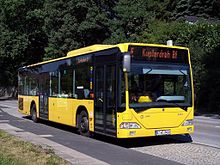E-car



As e-cars are in the public transport German speaking countries courses referred to, in addition to regular timetable will be offered to order the regular services on high-demand sections increase . In Switzerland one also speaks of the supplement car . Such additional cars can generally be found during rush hour . In addition, they also operate
- as special trips of various kinds, especially for school trips
- in (seasonal) excursion traffic to local recreation areas or other tourist destinations
- at sporting events, concerts or similar major events
- in rail replacement traffic
- for deviations due to construction site
- when entering or leaving a depot
- as a staff car
- for in-house journeys without a ride
- as accelerated journeys that do not serve all intermediate stops
- in All Saints' Day traffic to cemeteries on November 1st
Definition of the letter E.
The letter E stands for:
| Interlining -coming (e) - hardening insertion insertion drawing- catchment relief spare extra express express |
-Fahrt -Course trolleys -zug -bus -line |
description
E-cars often run immediately before or after a regular course that is in high demand in order to specifically avoid overcrowding. On single-track routes, this usually takes place in so-called follow - up train operations . The additional course is also referred to as a double car or - depending on the position on the standard course - as a preference or a follow-up .
E-cars are often not on the timetable. They can therefore be dispensed with or postponed at any time, for example in the event of a lack of vehicles, staff shortages, weather-related problems or short-term changes in school operations. There is therefore neither an operating nor a transport obligation . Sometimes they are deployed at short notice when needed, for example after major events. It is not uncommon for older vehicles to be used for e-cars, which otherwise only serve as a reserve. The theater car represented a special form of emergency vehicle, late in the evening they waited in front of a theater house for visitors to a theater performance to bring them home.
variants
There are basically three different variants of e-cars:
- Operational lines come closest to regular scheduled services. These are special amplifier - lines at peak times. They usually run on a regular schedule and are recorded in the timetables and network plans. As a rule, they have an official line designation, whereby this can be distinguished from regular lines that run all day with an additional E as a suffix (for example line 1E) or prefix (for example line E1). Operational lines often offer additional direct connections that are not offered outside of rush hour.
- Non-line-bound e-cars are needs-based individual trips, for example at the beginning of and / or end of school, which also deviate from the route of regular lines and are therefore usually only marked with a neutral E. Similar to the operational lines, they also offer additional direct connections that are not offered in regular traffic. The "E", often visually conspicuous in white letters on a red background or red letters on a white background, replaces the regular line designation.
- Line-bound e-cars are also needs-based individual journeys, but they follow a regular line route over their entire route , even if they are often only “briefly guided” to or from an intermediate terminus. With them, too, the letter E is sometimes used as a suffix or prefix for the numerical line designation. Alternatively, the regular line designation is used, but is shown as a red line number or a dashed line number . In still other cases the normal line number is used without any additional information. In the latter case, the passenger - without knowing the timetable - does not recognize that it is an electric car.
gallery
E-car in Leipzig , typical is the striking representation of the letter "E" in white letters on a red background.
Special trip on the occasion of the opening of the Freiburg im Breisgau tram , here in red on a white background.
Tram Halle (Saale) : In addition, the line destination is also shown in red text on a white background, instead of in white text on a black background, as is the case with the line cars
The Woltersdorf tram also uses the letter E for driving school trips.
Karlsruhe tram : Line signal E in black letters on a white background on the occasion of a historical special trip in 1993.
Trivia
The public utilities public transport company Frankfurt use since the 1970s instead of the "E" for "E-car" alternatively the letter "V" for "amplifier". The reason for this was the risk of confusion with the “E” signage introduced at the time for validators or one-man cars . This V is also used in Aachen, Bonn and Mannheim .
See also
- Relief train
- Extra train (Switzerland)
Web links
- E-Wagen - The connection for schoolchildren at www.stadtbus-sha.de
- E-cars supplement our timetable on www.stoag.de
- Emergency vehicle trips in school traffic on bogestra.de
- E-railways on kvb-koeln.de
Individual evidence
- ↑ Line signal E for inlay line. In: Eisenbahnverkehr aktuell, October 1990, p. 32
- ↑ E-car overview on roehler.eu









